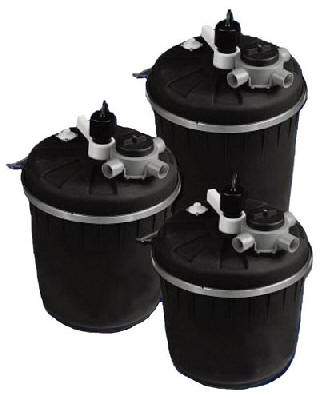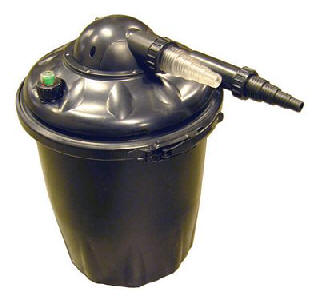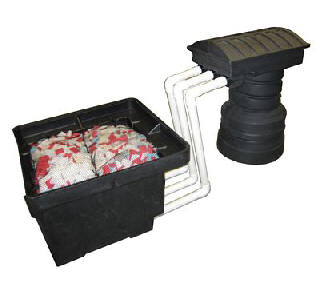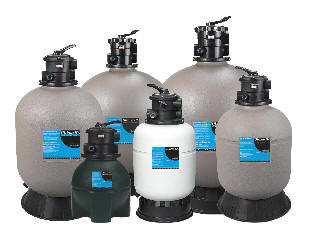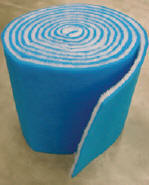There are no products listed under this category.
Choose a Pond Filter
Pond FilterA pond filter is one of the most important components of any garden pond whether it be a fish pond or simply a water garden feature. Getting the correct size of fish pond filter is one of the pond owner's most common mistake. Allow us to help you choose the correct one. Below, you will find some information regarding various types of pond filters including how they're used and how they differ. All types of pond filtration systems consist of a pond filter, filter media, a pond pump and pump tubing. Some koi pond filters have a built in UV clarifier. You will need electricity near the pond to run the pump and the optional UV (ultraviolet clarifier or sterilizer). The first kind of pond filter is a submersible filter. This can be located inside the pond. On one end of it (or even within the filtering unit) is the pump with a tubing connected to its discharge side. This discharge side usually has a pipe threaded or barbed threaded nipple where the tubing can be attached to. You'll attach the tubing to the intake area of the water pond filter. (We have a variety of tubing and connector pieces under 'Plumbing Accessories' on our site.) The advantage of having a pond filter that is submersible is that it is out of sight and can be hidden in the pond. Most of them are made out of black plastic which can be easily be camouflaged and somewhat hides with a black pond liner in the background. The disadvantage of having the garden pond filter inside the pond is that it can be inconvenient to get to and clean it out. Another type of fish pond filter is an external filter. As the name suggests, this filter does not get submersed within the pond but sits somewhere on land. As to where you locate your filtering system, that's up to you, your plumbing system and how far you want your filter from your pump. The further the distance, the larger the pump you may need to push the water to your filter. ( If you want it close to the pond and want to camouflage it, you might want to consider one of our fake rock covers to cover it.)
To determine the size of your fish pond filter you will need to know how many gallons of water your pond holds. For those with preformed ponds, this can be easy as it will state right on the unit. For those who have created their pond with a pond liner, you will have to do a little math. To calculate the number of gallons your pond holds, this is the typical formula: Length of the pond times width of the pond times depth times 7.5. This will be the number of gallons your garden pond holds. Say that you calculated that your pond holds 3,000 gallons of water. You will need to filter this total volume of water every 3 to 4 hours. So, divide 3,000 gallons by 3 and you get 1,000 gallons every hour. This would be part of the information you need to determine what size of pond filter to get. Koi pond filters are designed to adequately filter a certain volume of water along with a particular size of fish load. A fish load basically means, how many fish you have and what size they are. This is where the majority of people make a mistake so please pay attention to this. Getting the wrong size of pond filter is one of the most common mistakes most fish pond owners make. If you have a pond that holds 3,000 gallons and are looking at a pond filter that filters 1,000 gallons you're only partly on the right track. You will need to look at the specs for the filter to see how large of a fish load this filter is for, too. If the manufacturer states that it is only for a fish pond with 5 or 6 fish that are 6" long, and you have 30 fish that are 6" long, then this will not be the correct size of filter for you. You will need a filtering system that is much larger or else you will have to get rid of a lot of fish so you are within the parameters that the filter is suitable for. This is where so many people make the mistake. Either they get the wrong size of fish pond filter to begin with or they may get the right size filter but the fish multiply thereby putting more demands on the pond filtration where it can no longer do an adequate job keeping the pond clean.
To properly clean your pond filter pads, simply use some clean pond water - not tap water. Put the water in a large bucket and swish the pads around in it. You can also bang your filter pads along the pavement or side of the bucket which will help dislodge the larger particles. We are happy to help you select which type of pond filter you may need. We know the math and everything can be a little tricky for some folks particularly when you're calculating what size of pond pump you need for the filter and for a water feature. A simple solution for new pond owners is to buy a pond kit which has everything you need to create a beautiful pond. At PondSolutions.com we have 1000s of quality pond products. Let us know how we can help you enjoy your water feature even more - with the right selection of pond supplies and friendly, helpful advice. |

